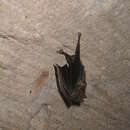en
names in breadcrumbs


Perception Channels: tactile ; chemical
No special status was reported for Brachyphylla nana.
US Federal List: no special status
CITES: no special status
IUCN Red List of Threatened Species: least concern
No negative impact on humans was reported.
Because of the highly variable diet in this species, they may be good pollinators and they may help control insect populations in some areas.
Brachyphylla nana are known to be opportunistic feeders. Their diet consists of pollen, seeds, fruit nectar and insects.
Brachyphylla nana is found in "Cuba, Isle of Pines, Grand Cayman, Hispaniola, & Middle Caicos" (Walker, 1999).
Biogeographic Regions: neotropical (Native )
Brachyphylla nana is a cave dwelling species. In Cuba, they prefer deep caves that are often hot and humid. In Middle Caicos, where there are no deep caves, they seem to be more opportunistic in their selection of habitat, and will live in cooler, less humid caves. Colonies of Brachyphylla nana in Cuba have been estimated to contain between 2,000 and 10,000 individuals.
Brachyphylla nana has a very small vestigial nose leaf. The lower lip has "a V-shaped groove margined by tubercles" (Walker, 1999). The tubercles also line the portions of the upper lip on either side of the muzzle. The ears are medium sized, and form a slightly rounded V-shape at the top. Brachyphylla nana has a well-developed uropatagium with a concealed, vestigial tail. The species is typically light brown to ivory in color with reddish or yellowish tones. The neck, shoulders and sides are usually paler in color (grayish-white) than the rest of the body, and the underside is brown.
Average mass: <45 g.
Other Physical Features: endothermic ; bilateral symmetry
Females form maternity colonies after mating. Mating begins in October. During this period, the colony may occupy parts of the cave which typically remain uninhabited during the rest of the year. Females usually give birth to a single infant between December and May.
Key Reproductive Features: gonochoric/gonochoristic/dioecious (sexes separate); sexual
The Cuban fruit-eating bat (Brachyphylla nana) is a species of bat in the family Phyllostomidae found in the Cayman Islands, Cuba, and Hispaniola (both the Dominican Republic and Haiti).It has been extirpated from the Bahamas and Jamaica.[1]
The Cuban fruit-eating bat (Brachyphylla nana) is a species of bat in the family Phyllostomidae found in the Cayman Islands, Cuba, and Hispaniola (both the Dominican Republic and Haiti).It has been extirpated from the Bahamas and Jamaica.